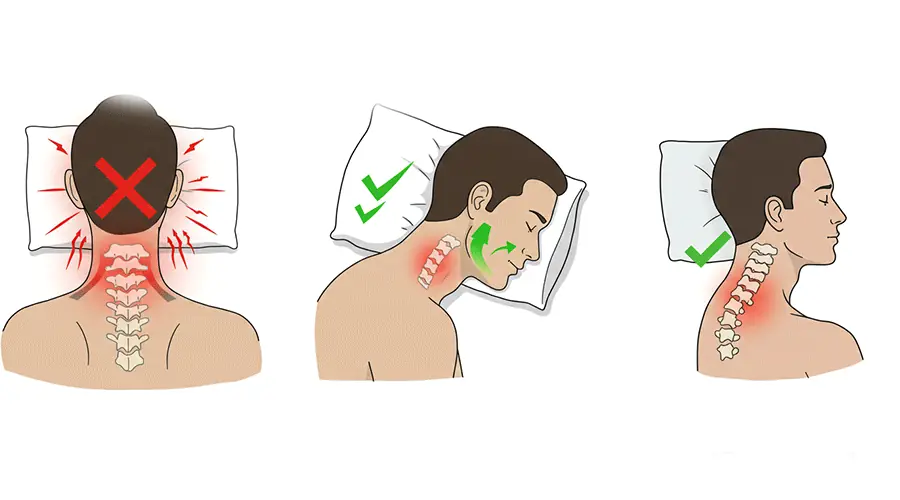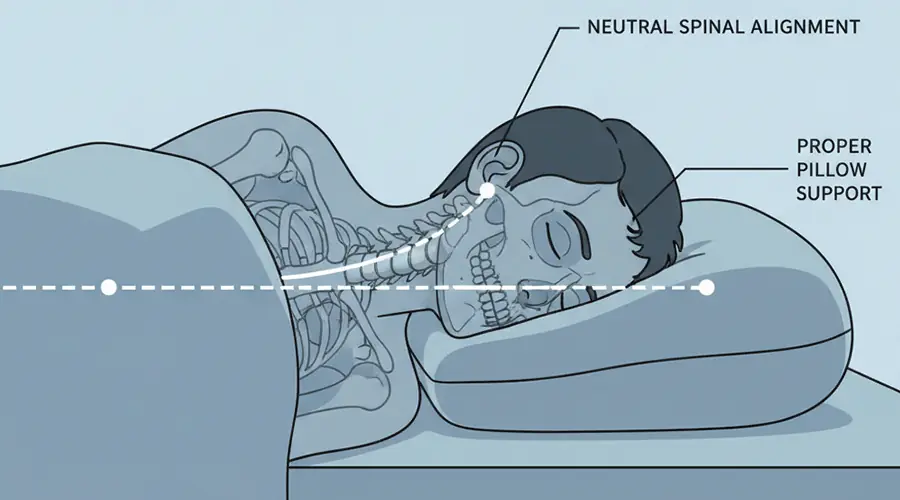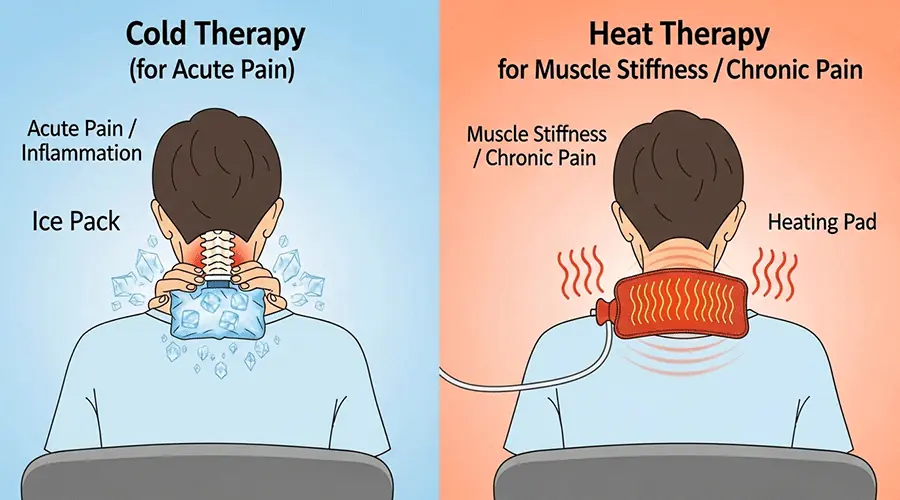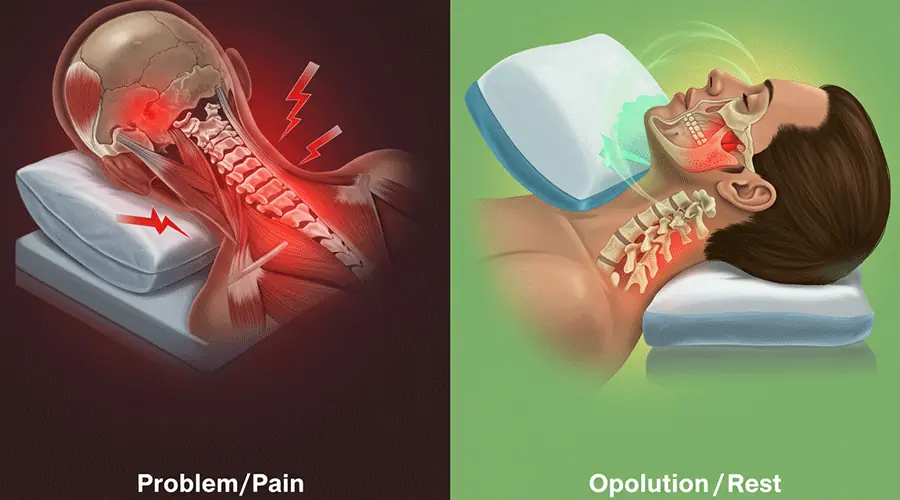Waking up with neck pain or stiffness is a common and frustrating experience that can disrupt daily activities and negatively affect your mood. While these aches are often minor and temporary, chronic or recurring symptoms should not be ignored. This article is designed to be a complete, credible, and reliable health guide to understand the root causes of this problem, provide practical solutions for immediate relief and long-term prevention, and identify when it's time to see a doctor.
Contrary to the popular belief that morning neck pain is solely due to a poor sleeping position, evidence shows it is often the result of a vicious cycle of poor daily and nightly habits that influence each other. In this report, we will explore these factors and their complex relationships to provide a comprehensive approach to managing this condition.
Why Does Our Neck Hurt When We Wake Up? (Exploring the Main Causes and a Vicious Cycle)
Morning neck pain rarely has a single cause; rather, it is the result of accumulated stress and strain from several different sources. Factors such as sleeping position, pillow type, daily habits, and even underlying medical conditions can play a role in causing or exacerbating this pain.
1.1 Improper Sleeping Position: The Number One Culprit
Your body's position during sleep is one of the most significant factors affecting the health of your cervical spine. Sleeping on your stomach is recognized as the most likely cause of morning neck pain. In this position, you are forced to turn your head to one side for hours to breathe. This prolonged rotation puts intense pressure on the neck muscles, tendons, and joints, leading to severe strain and stiffness, which results in pain upon waking. This is a direct cause-and-effect chain where prolonged mechanical pressure is converted into muscle spasms.

In contrast, sleeping on your back (supine) or your side are the best positions for maintaining the neutral alignment of the cervical spine. These positions allow the head and neck to align with the rest of the spine, preventing severe twists and bends.
1.2 The Wrong Pillow and Mattress: Inadequate Spinal Support
A suitable pillow plays a vital role in supporting the natural curve of your neck. An ideal pillow should offer a balance of softness and support. Pillows that are too firm or too high push the head forward, straining the cervical spine's curve. On the other hand, pillows that are too soft can also be problematic, as they allow the neck to bend too far backward or sideways. The primary goal of a pillow is to keep the cervical spine in a neutral, pressure-free position.

Pillow material is also important. Feather or memory foam pillows provide good support because they conform to the shape of your head and neck. Memory foam and latex pillows are particularly recommended for reducing neck pain. However, it's important to note that the "best pillow" is not a one-size-fits-all concept; it depends on your sleeping position. For example, a side sleeper needs a higher pillow to fill the space between the head and shoulder, keeping the spine straight. In contrast, a back sleeper is better off with a lower, flatter pillow.
In addition to the pillow, the mattress also plays a role in maintaining spinal alignment. A mattress should be medium-firm to support the spine and prevent sagging in the middle. Old, worn-out mattresses (over 8 years old) that have a dip in the center can directly contribute to neck and back pain.
1.3 Daytime Posture: The Roots of "Tech Neck"
Morning neck pain is often the result of hours of accumulated pressure and stress throughout the day. Prolonged use of electronic devices with the head bent downward (a condition known as "Tech Neck") places significant strain on the neck and shoulder muscles. This posture can lead to a chronic flattening of the natural neck curve and, in the long term, contribute to degenerative issues like cervical osteoarthritis.
Furthermore, slouching or sitting improperly during the day causes muscles to become tight and contracted. These muscle spasms do not resolve during the night's rest and can manifest as morning pain. This illustrates a vicious cycle: poor daytime posture causes tension and strain, improper sleep at night exacerbates this pressure, and you ultimately wake up in pain. This shows that to solve the problem at its root, daily habits must be addressed, not just nighttime solutions.
1.4 Spinal Conditions and Sleep Disorders: Underlying Causes
Sometimes, morning neck pain is a symptom of an underlying medical issue that requires professional attention. Chronic orthopedic conditions such as osteoarthritis, a herniated disc, or spinal stenosis can cause chronic pain that worsens with pressure during the night.
Additionally, sleep disorders like insomnia and obstructive sleep apnea can indirectly affect neck pain. These disorders reduce the body's ability to repair itself and increase a person's sensitivity to pain. This means an underlying condition (like arthritis) can combine with a sleep disorder to create a cycle of more intense and frequent pain.
Immediate Neck Pain Relief (At-Home, In-the-Moment Solutions)
When faced with morning neck pain and stiffness, the first step is often to seek quick relief. Several conservative, at-home methods can help reduce discomfort and restore mobility.
2.1 Heat and Cold Therapy: How and When to Use Them

- Cold (Ice): For acute, new pain (less than 72 hours) or if there is inflammation, using an ice pack is recommended. Cold constricts blood vessels, helping to reduce swelling and inflammation at the site of injury.
- Heat: For chronic pain or muscle tightness, heat is ideal. Heat increases blood flow to the muscles, helping them to relax and reduce stiffness.
For both methods, apply for 10-20 minutes at a time.
2.2 Over-the-Counter (OTC) Medications: Temporary Pain Relief
Nonsteroidal anti-inflammatory drugs (NSAIDs) like ibuprofen (Advil, Motrin) and naproxen (Aleve) can help reduce inflammation and relieve pain. Acetaminophen (Tylenol) is also effective for pain relief. These medications are a temporary solution and should not be considered a substitute for addressing the root cause of the problem.
2.3 Stay Mobile and Gentle Massage: Avoid Immobilization
Contrary to old beliefs, complete rest and immobilization of the neck are not recommended. Gentle movement within a pain-free range can help improve blood flow to the muscles and reduce stiffness. Gently massaging the painful area can also help relax the muscles.
4 Practical Stretches and Mobility Exercises for Neck Stiffness
Regularly performing stretching and strengthening exercises is a key part of managing and preventing neck pain. These exercises should be done slowly and within a pain-free range. If you experience numbness, tingling, or sharp pain, stop immediately and consult a professional.
3.1 Levator Scapulae Stretch
This stretch targets the levator scapulae muscles, located at the back and sides of the neck, connecting to the shoulder blade. While seated, place one hand under your chair or on your thigh to keep the shoulder down. Gently turn your head to the opposite side, bringing your chin down towards your opposite armpit. Hold for 30 seconds, then slowly return to the starting position.

3.2 Upper Trapezius Stretch
This stretch helps the upper trapezius muscles on the sides of your neck. First, gently perform a "chin tuck" to align your spine. Then, slowly tilt your head to the side, bringing your ear toward your shoulder until you feel a stretch along the side of your neck. For a deeper stretch, you can use your opposite hand to apply gentle pressure to your head.
3.3 Towel Extension Mobilization
This movement uses a towel to create a traction force, which helps separate the vertebrae and reduce pressure on the joints. Place a rolled-up towel around your neck (at the painful area) and hold the ends with your hands. Gently look up and extend your head backward while using the towel to apply a gentle forward/downward pressure. Repeat 10-15 times.
3.4 Towel Rotation Mobilization
This exercise helps improve the neck's rotational range of motion. Place the towel behind your neck and hold one end over the opposite cheek of the painful area. As you rotate your neck, use the towel to apply gentle pressure to help increase the range of motion.
Long-Term Prevention and Habit Changes: Sustainable Solutions
To prevent the recurrence of morning neck pain, focus on correcting daily and nightly habits. Prevention is a comprehensive approach that includes improving sleep posture, practicing good daytime ergonomics, and regular exercise.
4.1 Choosing the Right Pillow and Mattress: The Cornerstone of Good Sleep
As mentioned earlier, selecting the right pillow and mattress is essential for maintaining the alignment of your cervical spine. The ultimate goal is to keep the spine in a neutral position to prevent overstretching of muscles, tendons, and ligaments.
Guide to Choosing a Pillow and Mattress Based on Sleeping Position
| Sleeping Position | Ideal Pillow Type (Shape & Material) | Recommended Height & Firmness | Key Details |
|---|---|---|---|
| Back Sleeper | Memory foam or feather pillow with a flatter surface | Low to medium height (3-5 inches) and medium firmness | The pillow should fill the curve of the neck without pushing the head forward. |
| Side Sleeper | Taller memory foam or latex pillow | Medium to high height (3-5 inches) and firmer | The pillow should fill the space between the head and shoulder to keep the spine straight. A pillow between the knees can help align the entire spine. |
| Stomach Sleeper | A very thin pillow or no pillow | Low height (3 inches or less) and soft firmness | This position is not recommended due to severe neck strain. If unavoidable, a thin pillow helps reduce pressure. |
Medium-firm mattresses are recommended for spine support and should be replaced every 6-8 years.
4.2 Postural Hygiene (Ergonomics): Combatting Daily Habits
Correcting postural habits during the day can help reduce cumulative stress on the neck. The golden rule is to position your computer or phone screen at eye level to avoid bending your head down. This is a simple and effective strategy that directly addresses the root cause of "Tech Neck."
Other practical tips include maintaining a proper sitting posture with shoulders back and chin slightly tucked, using an ergonomic chair with proper back and neck support, and periodically using a standing desk.
4.3 Sleep Hygiene: Improving Overall Sleep Quality
Quality sleep allows the body to repair itself and reduces pain sensitivity. Maintaining a regular sleep schedule, creating a quiet and dark sleep environment, and reducing the use of electronic devices before bed can help improve overall sleep quality.
When Should You See a Doctor? (Red Flag Warning Signs)
Self-treatment and home remedies are only suitable for minor, temporary pain. Under the following circumstances, it is essential to consult a healthcare professional (such as a doctor, physical therapist, or orthopedic specialist).
| Symptom Type | Description | Potential Implication (in simple, non-diagnostic terms) | Recommended Action |
|---|---|---|---|
| Chronic or Recurring Pain | Pain that lasts more than a few days or a week, or does not improve with home care. | Could be a sign of an underlying issue like arthritis or a herniated disc. | Consult a doctor. |
| Neurological Symptoms | Numbness, tingling (paresthesia), or weakness in the arms or legs. | May indicate nerve compression or damage (like cervical radiculopathy) or even spinal cord compression. | Seek immediate medical evaluation. |
| Acute and Severe Pain | Severe pain that starts suddenly without a clear cause. | Could be a sign of a more serious injury. | Seek immediate medical attention. |
| Accompanied by Systemic Symptoms | Neck pain accompanied by fever, severe and unexplained headaches, stiff neck (difficulty bending head), trouble swallowing, unexpected weight loss, or swollen glands. | These symptoms could indicate a more serious condition like an infection (e.g., meningitis) or autoimmune disease. | Go to an emergency room or see a doctor immediately. |
| History of Trauma | Neck pain following an accident or injury (like a car crash or sports injury). | There is a risk of a vertebral fracture, dislocation, or serious injuries like whiplash. | Seek immediate medical evaluation. |
Summary and Conclusion
Morning neck pain is a complex issue rooted in a combination of factors, including poor sleeping posture, the wrong pillow and mattress, and poor daytime postural habits. These factors operate in a vicious cycle, ultimately leading to pain and stiffness upon waking.
By adopting a comprehensive approach that includes correcting sleep position (sleeping on the back or side), choosing appropriate sleep equipment (supportive pillow and mattress), improving daytime postural hygiene, and performing regular stretching and strengthening exercises, you can effectively manage and prevent this problem. Finally, it is crucial to remember that none of these solutions are a substitute for medical advice. If you experience any warning signs or if the pain does not improve, consulting a medical professional is a necessity. This responsible approach helps users move toward a sustainable and safe solution instead of just temporarily managing symptoms.



